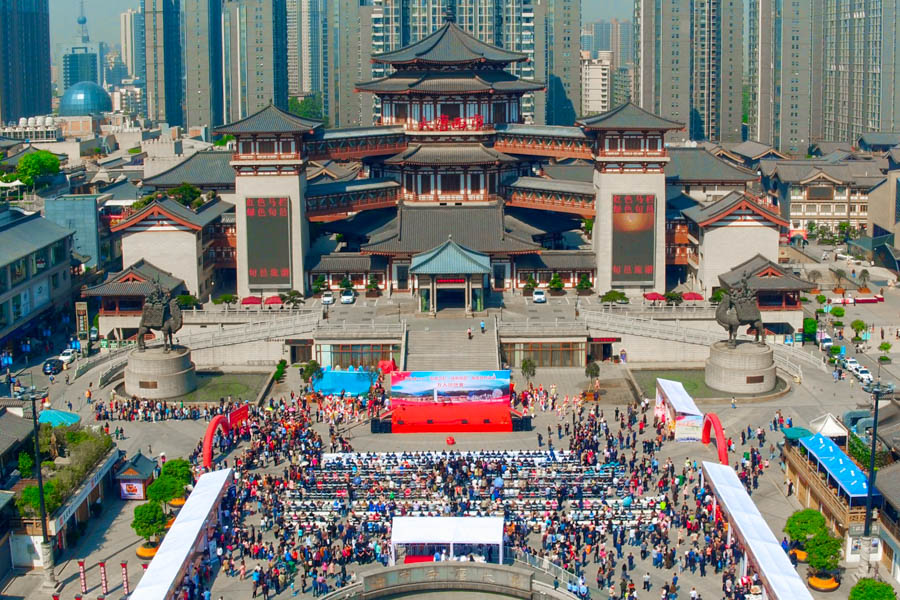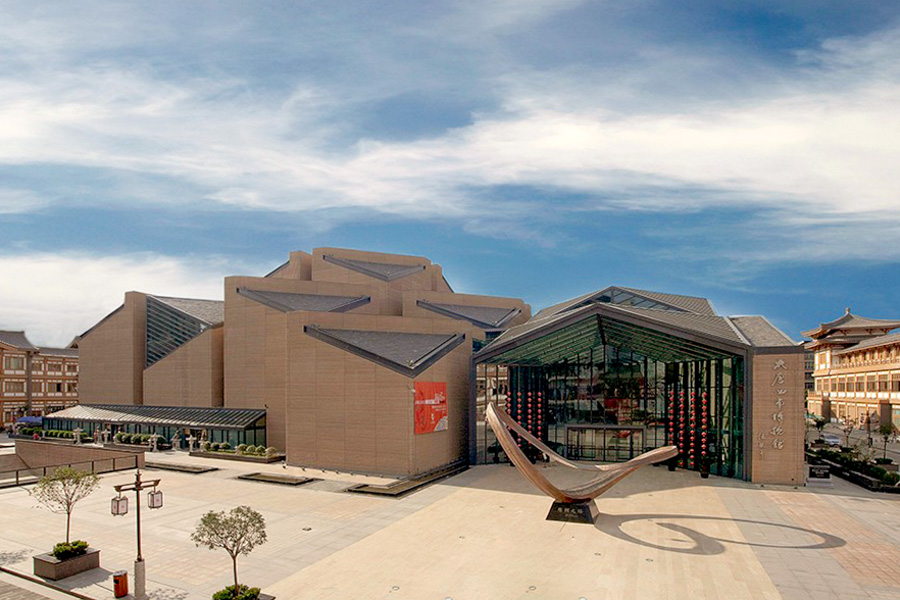
Photo source: www.dtxs.cn
Tang West Market Cultural Scenic Area is a large cultural, educational, and commercial complex built on the site of the ancient bazaar that once served as the main starting point of the Silk Road. Today, the area features gold and antique markets, boutiques, restaurants, hotels, and exhibition halls. A major highlight is the Tang West Market Museum, which preserves rare artefacts - valuable examples of material cultural heritage.
The complex’s main building, home to a network of shopping arcades, is divided into several themed pavilions: Chinese Pavilion, Japanese Pavilion, Korean Pavilion, Indian Pavilion, Buddhist Art Pavilion, Thai Pavilion, Malaysian Pavilion, Iranian Pavilion, and Western Region Pavilion.
Each pavilion offers shopping and exhibition spaces dedicated to a specific culture, reflecting its historical role in the development and cultural exchange along the Silk Road and within the broader region of Xi’an. Covering 160,000 m², Tang West Market is the largest urban complex in Xi’an. Its pavilions host Chinese and international brand stores selling clothing, accessories, cosmetics, jewellery, children’s products, and much more.
History
Located in the southwestern part of Chang’an during the Tang Dynasty (618–907 AD), Tang West Market was the largest trading center of its time. Archaeological findings reveal a meticulously planned layout: the complex stretched 1,031 meters from north to south and 927 meters from west to east. It was divided into nine rectangular sections, bordered by streets up to 16 meters wide, with smaller alleys running within each block. At its height, the bazaar drew as many as 150,000 visitors a day.
In 835, a massive fire destroyed Tang West Market, leaving behind only written accounts of its former splendor. From the 1960s onward, archaeologists carried out excavations that confirmed the scale of the site. In April 2010, the Tang West Market Museum opened on the grounds of the former arcades, where visitors can now view the ruins of ancient buildings preserved beneath a glass canopy.
In 2011, it was officially included in the joint international nomination to the UNESCO World Heritage List under the name “Eastern Starting Point of the Great Silk Road”. It has also been designated a “AAAA National Tourist Attraction” in recognition of its outstanding organisation, visitor services, cultural preservation, and tourism appeal.
Things to Do
Visit Silk Road Shopping Street, a vibrant pedestrian zone that captures the spirit of Xi’an during its golden age. The promenade’s design reflects the cultural traditions of 22 countries historically connected to the Silk Road. Along the street, you’ll find a Japanese five-story pagoda, a Turkish Grand Bazaar, an Indian Red Fort, a Roman Forum, and other recognizable architectural motifs. The street is lined with souvenir shops, antique and collectible boutiques, restaurants, snack stalls, and spaces for live performances. Shoppers can browse for jewelry, ceramics, paintings, Chinese calligraphy, and other unique items.
Explore the International Shopping Center (西市城·购物中心) – one of the largest commercial complexes in Xi’an, home to a wide range of Chinese and international brands. The center also features supermarkets, cinemas, children’s play areas, restaurants, a banquet hall for up to 1,000 guests, and a rooftop garden. It spans two underground and four above-ground floors, with a parking facility for 2,000 vehicles. In addition to shopping and dining, the venue regularly hosts press conferences, business meetings, and other major events.
Experience the Temple Fair, held annually from lunar January 1 to 15, when the main shopping streets transform into an open-air market filled with rare and decorative finds. Alongside modern boutiques and souvenir stands, stalls overflow with embroidered carpets, handmade figurines, jewelry, carved wooden boxes, tea sets, paintings, antique trinkets, and thousands of collectible items.
Tang West Market Museum

Tang West Market Museum (大唐西市博物馆) was the first private museum in China to be built directly on the site of an archaeological excavation. Its central theme is the culture of the Silk Road and the historical significance of Xi’an as a major centre of East-West exchange.
The museum collection includes more than 20,000 artefacts, showcasing a remarkable range of objects from the Shang Dynasty (16th–11th centuries BC) to the Qing Dynasty (1636–1911), with a special focus on the Tang Dynasty, which marked Xi’an’s golden age. Visitors will find bronze vessels, brightly glazed ceramics, expressive terracotta figures, gold and silver ornaments, fine silk fabrics, and intricately carved jade. The museum also houses ancient coins, epitaphs, religious objects, and architectural elements, all arranged in spacious galleries that create a vivid and immersive cultural experience.
The museum’s exhibitions are distributed across four floors, each offering a unique perspective on the region’s historical and artistic legacy.
Many of the artefacts were excavated directly on-site, while others come from the private collection of Mr Lu Jianzhong, Chairman of the Board of Xi’an Tang West Market Museum and Founding Chairman of the Silk Road Chamber of International Commerce (SRCIC).
The first floor presents rare pieces from the personal collection of Mr Lu Jianzhong, including handcrafted sculptures, musical instruments, and interior décor. This level also includes the Art Space Hall and a lecture Hall for public events and cultural programming.
The second floor hosts the exhibition “A Thriving Trade Center at the Starting Point of the Silk Road,” which explores the history of the original Tang-era market that once stood on this very site. Highlights include Tang Tri-coloured Glazed Pottery with figures of camels and horses—animals vital to Silk Road trade—as well as remnants of ancient buildings and drainage channels from different historical periods.
On the third floor, the exhibition “Hands-on Experience of the Silk Road Crafts” introduces ten traditional art forms that reflect the rich cultural heritage of Xi’an artisans. This floor also features the Silk Road Coins Exhibition, which presents a significant numismatic collection. Some coins date back to the 2nd millennium BC and originate from the Greco-Bactrian Kingdom (256–145 BC), Parthian Empire (247–226 AD), Hephthalite Empire (6th century AD), Kushan Empire (45–360 AD), and Sassanid Empire (224–651 AD). These treasures offer powerful evidence of Xi’an’s role as a vital crossroads of ancient civilisations.
The fourth floor is home to three major exhibitions. The Exhibition of Coins and Porcelain displays ancient coins alongside refined examples of Chinese porcelain, tracing the economic and aesthetic legacy of the Silk Road. The Exhibition of Gold, Silver, and Jade Wares showcases jewellery and luxury objects that demonstrate sophisticated craftsmanship in precious materials. Finally, the Exhibition of Bronze Wares focuses on ritual and domestic bronze items, including vessels and tools that offer insight into religious and daily life in ancient China.
The museum’s overall exhibition programme is divided into five main sections:
- Basic Exhibition
- Thematic Exhibition
- Temporary Exhibition
- Special Exhibition
- Art Space
Architecture of the Tang West Market Museum
The architecture of the Tang West Market Museum echoes the layout of the grand urban market that once stood on this site during the Tang dynasty. The museum's modern structure mirrors the historical spatial arrangement, preserving the essence of its original design. At the same time, every element is executed in a contemporary style, highlighting the continuity of cultural traditions and underscoring the enduring link between the Silk Road’s history and the present-day evolution of Xi’an.
Geometric precision defines the building’s design. A light-filled atrium anchors the interior, while the varied levels of the sloped glass roofs evoke the expansive atmosphere of a bazaar, complete with the impression of lofty domes.
Museum Opening hours:
- Summer time: 8:30 am – 6:00 pm (ticket office closes at 4:30 pm)
- Winter time: 9:00 am – 5:30 pm (ticket office closes at 4:00 pm)
- The museum closes on every Monday.
Prices and Admission Tickets
- Admission to the museum’s permanent and temporary exhibitions (floors 1–3) is free of charge.
- Special exhibitions – 30 yuan per person. Group discounts are available for parties of 20 or more.
- Epitaph repository – 150 yuan per person. Advance booking is required at least one day prior to your visit.
- Guide services – 80 yuan per tour.
- Audio guide – 20 yuan per device.
- Ticket booking and collection – Tickets can be reserved and collected at the ticket office located opposite the museum’s south gate.
Phone number: +86-029-84351808 - Tickets are issued upon presentation of a valid ID.
How to Get to Tang West Market
The Tang West Market Museum is located at 118 South Laodong Road, Lianhu District, Xi’an. It lies approximately 200 metres north of the Caoyangcun bus stop and 200 metres south of the Electric Appliance Market.
- By bus: Routes 15, 24, 43, 106, 107, 156, 184, 201, 251, 262, 322, 502, 503, 518, 521, 720, 800, 916
- By metro: Take Line 6 to Datangxishi Station. Use Exit A toward Laodongnanlu Street (West).
Tang West Market is not only a modern commercial and cultural complex but also a powerful reflection of the cosmopolitan spirit of ancient Xi’an. Bringing together a museum, themed pavilions, shopping streets, and exhibition spaces, it preserves the tangible legacy of the Silk Road while seamlessly integrating it into the rhythm of 21st-century urban life. This is where history and modernity intersect in a unified cultural environment, inviting visitors to grasp the scale and importance of Xi’an as one of the world’s great centers of trade and cultural exchange.

